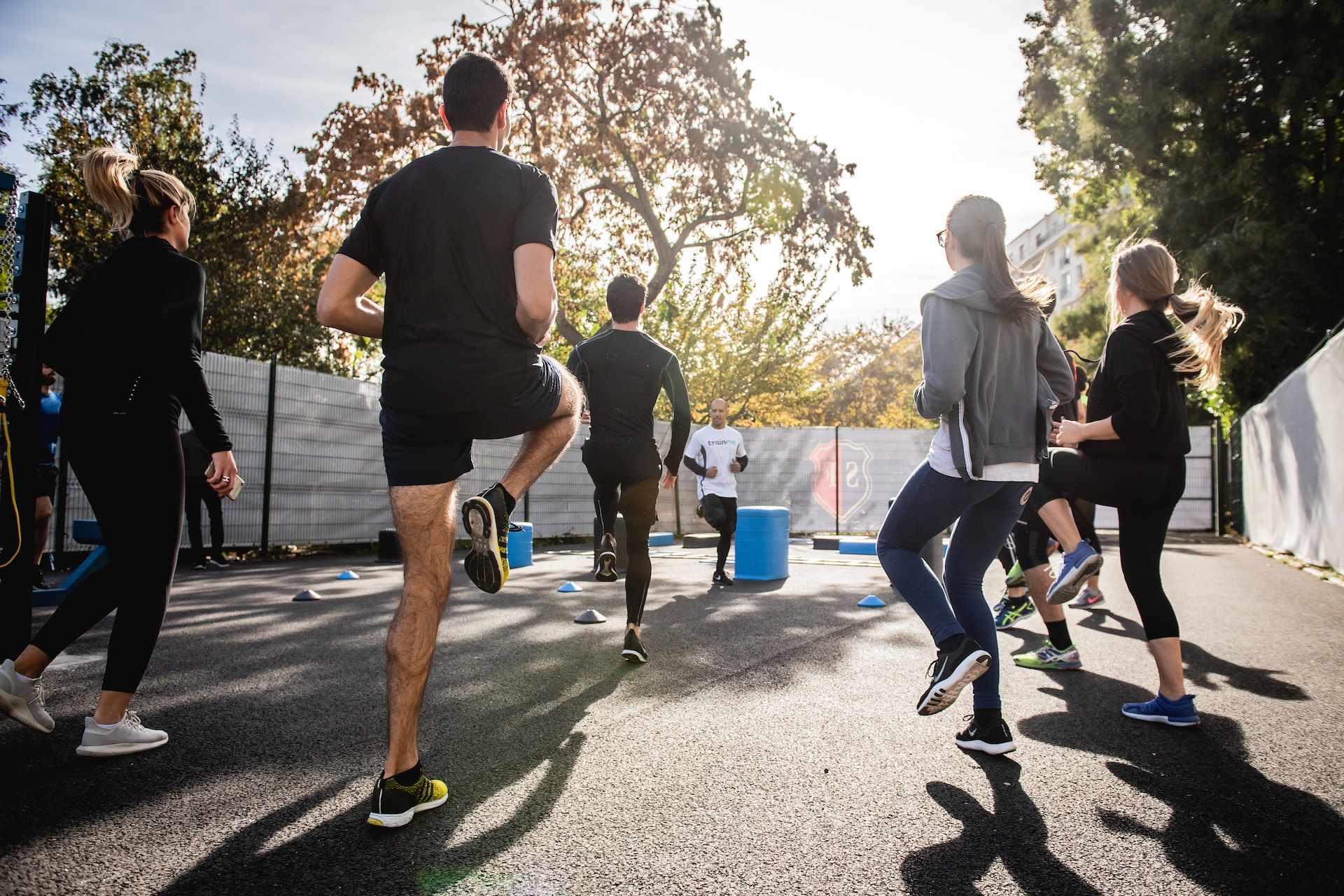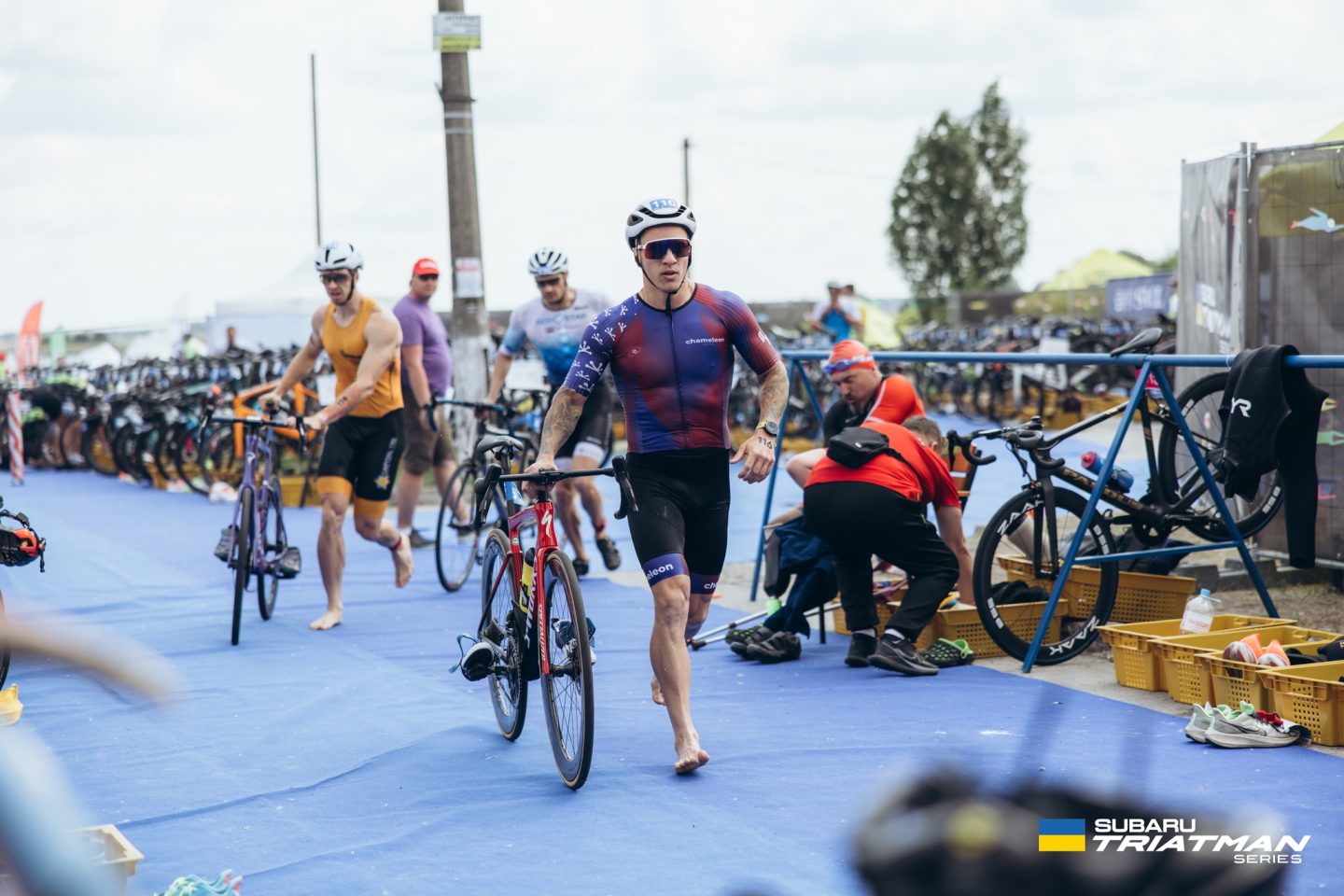Many professional triathletes I’ve talked to believe that out of three sports, triathlon running really is where most races are won or lost. And I think so too, because, as my experience in Sprint and Olympic distances shows, the athletes who can still run well after the bike portion are trained in a way that teaches their body to handle the fatigue.
To do that, you need solid running form, shoes that suit your stride and the course, and a training week that mixes steady runs, bricks, and strength work without draining you. This guide breaks down the key mechanics, endurance training habits, and race-day tactics that help you shift from just finishing the run to actually racing it.
We’ll start with the basics, and then move on to more specific and complex aspects of running in triathlon.
Why Running Matters So Much in Triathlon
I can’t stress this enough: running is where triathlon races are decided. Not always won, but certainly lost.
You can have the swim of your life and a solid bike, but a poor run erases all that work. Meanwhile, a strong run can salvage a difficult day on the bike or turn a good race into a great one.
The run is our last opportunity to execute our race plan. And it is not the same as our regular running rase as a standalone marathon or half marathon.
How Triathlon Running Differs From Standalone Road Races
If you’ve come to triathlon with a running background, you’ve probably experienced a humbling truth: your road race PRs don’t translate directly to triathlon. It’s because triathlon running is fundamentally different. Here are a few things that make triathlon run leg different:
- Starting conditions
In a road race, you line up fresh. Your legs are ready and your heart rate is low. You most probably are also mentally sharp and excited. In triathlon, you’re coming off 40 kilometers on the bike with your heart rate already elevated, your quads burning, and your hip flexors tight. You’re basically continuing an effort that began hours ago.
- Muscle recruitment
By the time you start running, your muscles have been working in specific patterns for extended periods. Now you’re asking them to switch to running mechanics while they’re already fatigued.
- Energy systems
You’ve already burned through significant glycogen stores as your body has been managing energy demands for swimming and cycling. The fuel tank isn’t full, and your body’s ability to process whatever fuel you’ve been taking in during the race is already taxed.
- Pacing reality
Your easy pace from training runs becomes your challenge pace in a triathlon. What felt conversational on fresh legs now requires focus and determination. Athletes who try to hit their standalone running paces early in a triathlon run often pay for it severely in the final kilometers.
Here’s the key insight: Your 5K PR means less in triathlon than how well you’ve trained your body to run when it doesn’t want to.
This isn’t meant to discourage you. Instead, it’s meant to reframe your expectations and triathlon training approach. Once you understand that triathlon running is its own skill, you can train for it specifically.

Triathlon Running Mechanics and Technique
When you’re tired, your form naturally degrades. In one study of club-level triathletes, doing a 40 km bike ride right before running significantly lowered the mechanical efficiency (work output vs. energy input) of running, compared to just running. Anaerobic energy cost increased, and that meant more wasted energy once you transitioned from bike to run.
Good running form in a triathlon is a survival strategy. No matter if it is a short-distance Sprint triathlon or longer races. Every unnecessary movement wastes energy you don’t have, and every mechanical inefficiency increases the stress on muscles that are already fatigued. The goal at this point is to stay efficient enough so that you can maintain your form when it matters most.
Let’s explore some key mechanics that can improve your running performance.
Running Mechanics That Survive the Bike
Your cycling position directly affects how you run. After spending 40-90 minutes bent forward on the bike, your hip flexors are tight, your back is locked in a forward position, and your core has been relatively relaxed. Now you’re asking your body to transition to an upright, dynamic running position.
This transition doesn’t happen instantly, and trying to force it leads to injury or terrible form. In the first few minutes of the bike-to-run transition, your form will feel awkward. And that’s completely normal. The goal is returning to good mechanics as quickly as possible, not starting with them.
Here are some tips to make this transition feel a little bit easier for you:
Opening up the hip flexors gradually
Your hips have been flexed for the entire bike leg. They need to extend to run properly, but they’re tight and resistant. The first kilometer of your run should include gentle, progressive hip extension. Don’t try to force a full stride length immediately. Let your body gradually remember what running feels like.
Some athletes find it helpful to include a few dynamic stretches in transition or in the first few hundred meters. These can be some gentle leg swings, high knees for a few steps, or focusing on pushing the hips forward.
Finding your natural stride length
Your stride will likely be shorter initially than it is on fresh legs. Don’t fight this. Trying to force a longer stride when your hips aren’t ready increases impact forces, wastes energy, and risks injury.
Start with a shorter, quicker stride and let it lengthen naturally as your body warms up. In fact, researchers have shown that stride length and coordination are temporarily reduced right after cycling, and they improve gradually as you run. So starting with a quicker, shorter stride is how your body naturally transitions.
Engaging your core
On the bike, your core was in a relatively stable position. Running requires dynamic core engagement to support your upright posture and transfer force effectively. In the first few minutes off the bike, many athletes slump forward because their core hasn’t reactivated yet.
Focus on standing tall. Think about lifting your chest slightly and engaging your core as if you’re bracing for a gentle push from the front.
Allowing your arms to help
Your arms provide rhythm and balance. When your legs are tired, active arm drive actually helps with leg turnover. Many fatigued triathletes let their arms go dead, which makes running harder, not easier. This is a common mistake for beginners who are doing their first triathlon.
You want to keep your arms at about 90 degrees, swinging from the shoulders (not just the elbows), moving forward and back rather than across your body. When you feel your legs struggling, sometimes focusing on arm drive helps restore your rhythm.
Here is a brief cheat sheet for a proper running form for your next training sessions:

Common Technique Mistakes in Triathlon Running
Every triathlete makes these mistakes at some point in their training. The difference between struggling through the run and executing well is noticing and correcting these mistakes. Let’s go through each one.
Over-striding to make up time
This one happens when you feel like you’re running slowly, and your instinct is to take bigger steps to go faster.
The problem is that over-striding increases your ground contact time, creates braking forces with each step, and dramatically increases impact stress on your joints and muscles. When you’re already fatigued, it slows you down and increases injury risk.
Focus on your running cadence instead of stride length. Quicker feet move you forward more efficiently than longer steps. Count your steps and aim for that 170-180 range. Let stride length come naturally as your body warms up and opens up.
Tensing up when uncomfortable
It’s a natural response to fatigue and discomfort. Your shoulders creep up, your jaw clenches, your hands form fists, and your entire body tightens.
This tension wastes enormous amounts of energy and restricts your breathing. Tight shoulders affect your arm swing, which, in turn, affects your rhythm. A clenched jaw often means you’re holding your breath or breathing shallowly.
Conduct regular form check-ins throughout your run. Every kilometer or at every aid station, do a quick body scan:
- drop your shoulders
- relax your jaw
- shake out your hands
- take a deep breath
Some endurance athletes set their triathlon watches to beep every 5 minutes as a reminder to relax.
Looking down constantly
This can happen for many reasons. You’re tired, you’re watching your footing, or you’re just trying to manage the discomfort by disconnecting from the experience.
However, looking down slightly closes your airways, making breathing harder. It also affects your posture, because your head weighs 10-12 pounds, and when it’s tilted forward, your upper back and neck have to work harder to support it. This creates tension and throws off your form.
Next time you are running, try to pick visual targets ahead of you. Look at a point 10-20 meters down the road. When you reach it, pick another one. This keeps your head up and gives you forward momentum mentally as well as physically.
Forgetting arm drive
When your arms feel heavy, you’re so focused on your legs that you let your arms just hang there or swing limply.
But that’s a problem, because your arms help drive your leg turnover. And when the arm drive stops, your rhythm falls apart, and your legs have to work harder. Active arm swing actually makes running easier, because it provides that momentum and rhythm.
So, when you feel yourself struggling, sometimes the best cue is focusing on your arms rather than your legs. Drive your elbows back with purpose, maintain that 90-degree bend, and let the forward-back swing remind your legs of the rhythm they should maintain.
Eventually, maintaining good form even when fatigued becomes automatic. That’s when triathlon running transforms from survival to execution.
Choosing the Right Footwear for Triathlon Running
The reality is that many triathletes overthink shoe selection or, conversely, grab whatever looks fast without considering whether it matches their needs. The best shoe is the one that feels good when you’re tired and supports the way you actually run.
Here is how to choose the best running shoes for your workouts and endurance events:

How to Test Your Shoes in Brick Sessions
This is the crucial step that many triathletes skip, and it’s a mistake. Shoes that feel great on fresh legs might not work at all after 40K on the bike.
The reality: Your feet swell during racing. Your stride changes when your legs are fatigued. Your preferences about cushioning and support shift when your muscles are pre-exhausted. The only way to know how shoes will perform in a triathlon is to test them in triathlon conditions.
Testing protocol:
- Do a moderate bike ride, 45-60 minutes minimum. This should be long enough to create some fatigue and get your heart rate elevated, but you don’t need to destroy yourself.
- Transition quickly, just like race day. Don’t rest. Don’t stretch for 10 minutes. Rack the bike, change shoes (if you’re testing different shoes than you bike in), and go.
- Run for at least 20 minutes at your expected race pace. The first few minutes will feel awkward regardless of the shoes—that’s the transition from bike to run. But by 5-10 minutes in, you should have a good sense of how the shoes feel.
- Note hot spots, pressure points, and how the shoe feels throughout the transition. Where does it rub? Does anything feel tight? Do you feel unstable? Is there enough cushioning?
What to assess:
- Comfort in the first 5 minutes: This is when your stride is still adjusting from bike to run. Do the shoes feel supportive as you’re finding your rhythm, or do they feel like they’re fighting you?
- Any rubbing or pressure points: Small irritations in a 20-minute brick become race-ending blisters in an Olympic distance race. If something rubs even slightly, it’s a problem.
- Cushioning when legs are heavy: Does the shoe provide enough cushioning when your legs are fatigued and less able to absorb impact? Or do you feel like you’re pounding the pavement with every step?
- Maintaining cadence and form: Can you maintain your target cadence comfortably? Or do the shoes feel like they’re slowing you down or forcing you to work harder than you should?
Pro tip: Test shoes multiple times in different conditions. One brick session isn’t enough to make a final decision. Try them in heat, in cool weather, when you’re fresh, when you’re tired from a hard training week. The more data points you have, the more confident you can be in your choice.
Red flags that mean keep looking:
- Any hot spots or blisters after just 20 minutes
- Feeling like you’re fighting the shoe to maintain your form
- Noticeable discomfort by 15-20 minutes
- Numbness or tingling, which often means the shoe is too tight or narrow
- Feeling unstable or unsupported through the transition phase

Building Your Triathlon Running Engine: Training Fundamentals
Many triathletes approach run training with the mindset that more is always better. But in triathlon, where you’re balancing three disciplines and recovery is limited, more running doesn’t necessarily mean better racing. What matters is the quality and specificity of your run training.
Here are some key triathlon running workouts you need to incorporate into your training schedule (any distance triathlon):
1. Easy Runs (60-70% of run volume)
Easy runs help you build your aerobic base and allow recovery from harder sessions. These are the foundation that everything else builds on.
Easy runs should feel… easy. You should be able to speak in complete sentences without gasping. If you’re breathing hard, you’re going too fast.
Easy runs develop your cardiovascular fitness, strengthen your connective tissues, teach your body to use fat for fuel (here is more about fat adaptation endurance training), and allow you to increase mileage running without excessive fatigue.
One obvious but still important thing to remember is that easy runs should feel genuinely easy. If you can’t maintain a conversation, slow down.
2. Threshold/Tempo Runs (15-20% of run volume)
Threshold runs improve your sustainable race pace. This is the same pace you can hold in a state of controlled discomfort.
These rounds should feel comfortably hard. You can speak in short phrases but not full sentences. You’re working, but it’s not an all-out effort. You could maintain this pace for 30-60 minutes.
Threshold training directly improves your triathlon race pace. It teaches your body to clear lactate efficiently, operate at higher intensities for longer periods, and maintain pace even when you’re fatigued.
A typical speed workout session includes a 10-minute warm-up, 20-40 minutes at threshold pace, and a 10-minute cool-down. Start with shorter intervals at threshold (like 3 x 8 minutes with 2 minutes recovery) and progress to continuous tempo runs.
3. Interval Training (10-15% of run volume)
Interval runs develop speed, improve running economy (how efficiently you use oxygen at any given pace), and build mental toughness. The last one is especially crucial for long-distance races like half Ironman or full-distance Ironman triathlons.
Run intervals are hard but controlled efforts with recovery periods. Each interval should feel challenging but not like an all-out sprint. You should be able to complete the workout at relatively consistent paces.
Intervals improve your VO2 max and make your threshold pace feel easier by comparison. They also teach you to handle pace changes during triathlon distance races when you need to respond to competitors or make a move.
Typical session includes a 10-minute warm-up, 5-8 x 3-5 minutes at 5K pace with equal recovery (e.g., 4 minutes hard, 4 minutes easy jog), 10-minute cool-down. Or: 6-8 x 800m at 5K pace with 400m recovery jog.
4. Long Runs (Once weekly)
Long runs build endurance, focusing solely on how you maintain a long course. It’s a perfect time to practice your fueling strategy and develop mental resilience.
These runs are conducted at a steady, moderate effort. You should start easy and can progressively build to a moderate pace, but this isn’t a race.
Long runs teach your body to keep running when it’s tired. They build the endurance necessary to handle the run leg after you’ve already been racing for hours. They’re also your opportunity to practice nutrition during the race and test race-day gear.
Long runs are built toward 1.5-2 times your race goal time. If you’re racing an Olympic distance (10K run), work up to 75-90 minute long runs. Shorter races, like a sprint distance, might be 45-60 minutes. Half Ironman might be 90-120 minutes.
6. Hill Repeats
Hill sprints are one of the easiest ways to build the strength (a part of strength training, of course) and form you need to run well after the bike workout. A gentle hill naturally forces good mechanics, such as quicker cadence, better posture, and a stronger push-off, without you having to overthink technique.
Cycling tightens the hips and loads the quads, so your stride often feels flat in the first minutes of the run. Hills help wake up the glutes and calves, which makes your stride feel smoother and more stable.
A simple hill workout is enough: find a moderate hill and run 6–8 repeats of 30 seconds uphill at a steady, strong effort, then jog back down easy. As you improve, you can add a few longer reps, but you don’t need anything complicated.
Brick Workouts – Learning to Run Off the Bike
This is the last aspect of triathlon running we’ll cover in this article, but it is as important as any other explored here.
No amount of standalone running fully prepares you for running off the bike. Brick workouts teach your body the specific adaptation it needs.
Both elite athletes and triathlon beginners will tell you that the first few minutes off the bike feel terrible. Your legs feel heavy, and your stride is off. Plus, your heart rate is elevated before you’ve even started running. This is the unique challenge of triathlon, and the only way to get better at it is to practice it regularly.
Brick workouts are about teaching your neuromuscular system to transition efficiently from cycling to running. Every brick session you do makes the next one slightly less awkward. Your body learns the specific coordination patterns, your muscles adapt to the unique fatigue profile, and mentally, you develop confidence that the terrible feeling will pass.
Brick progression by training phase:
Early Season (Base Building):
- Focus: Get comfortable with the transition sensation
- Frequency: Once every 7-10 days
- Structure: 30-45 minute moderate bike → 15-20 minute easy run
- Goal: Neuromuscular adaptation, not speed
In the early season, bricks are about familiarity. You’re teaching your body what this transition feels like and proving to yourself that it’s manageable. Keep the intensity moderate. The bike should elevate your heart rate but not destroy you, and the run should be easy enough that you’re focusing on form and rhythm, not survival.
Mid-Season (Build Phase):
- Focus: Increase duration and intensity gradually
- Frequency: 1-2 times per week
- Structure: 60-90 minute bike with some race-pace efforts → 25-35 minute run building to race pace
- Goal: Practice maintaining form and pace when fatigued
Race Preparation:
- Focus: Simulate race conditions
- Frequency: Every 5-7 days
- Structure: Race-distance bike at race effort → race-distance run at goal pace
- Goal: Rehearse race-day execution
These are kind of dress rehearsals. Everything about them should mimic race day: your nutrition timing, your transition routine, your pacing strategy, even your race-day gear. These sessions build confidence more than fitness level. You’re proving to yourself that you can execute your race plan.

Final Thoughts
Triathlon running is a distinct skill that rewards specific preparation. You now understand why it’s different, how to train for it, and what it takes to execute well on race day.
Most importantly, remember that the discomfort is part of the process. Every triathlete feels those heavy legs in the first kilometer off the bike. Every triathlete negotiates with themselves in the middle of the run. The athletes who run well aren’t superhuman, even though sometimes they look like ones. They’ve simply trained their bodies and minds to execute when it’s hard.
Your next race won’t feel easy. But with the right preparation, it will feel manageable. And that makes all the difference.







